Stable of Ireland: International Marketing Plan for South Africa
VerifiedAdded on 2021/08/30
|42
|7370
|1422
Report
AI Summary
This report evaluates the globalization of Stable of Ireland into South Africa. It begins with an executive summary and introduction to international marketing. The company overview details Stable of Ireland's background and aspirations. A situation analysis employs PESTLE analysis to assess the political, economic, socio-cultural, technological, environmental, and legal factors impacting the internationalization strategy, demonstrating greater prospects than risks. The report then outlines marketing objectives and strategies, including portfolio analysis, mode of entry, segmentation, targeting, and positioning. Marketing tactics cover product, price, place, and promotion. A marketing action plan and conclusion are provided, along with a bibliography and appendices including McKinsey’s 7 S model and Porters Five Forces analysis.
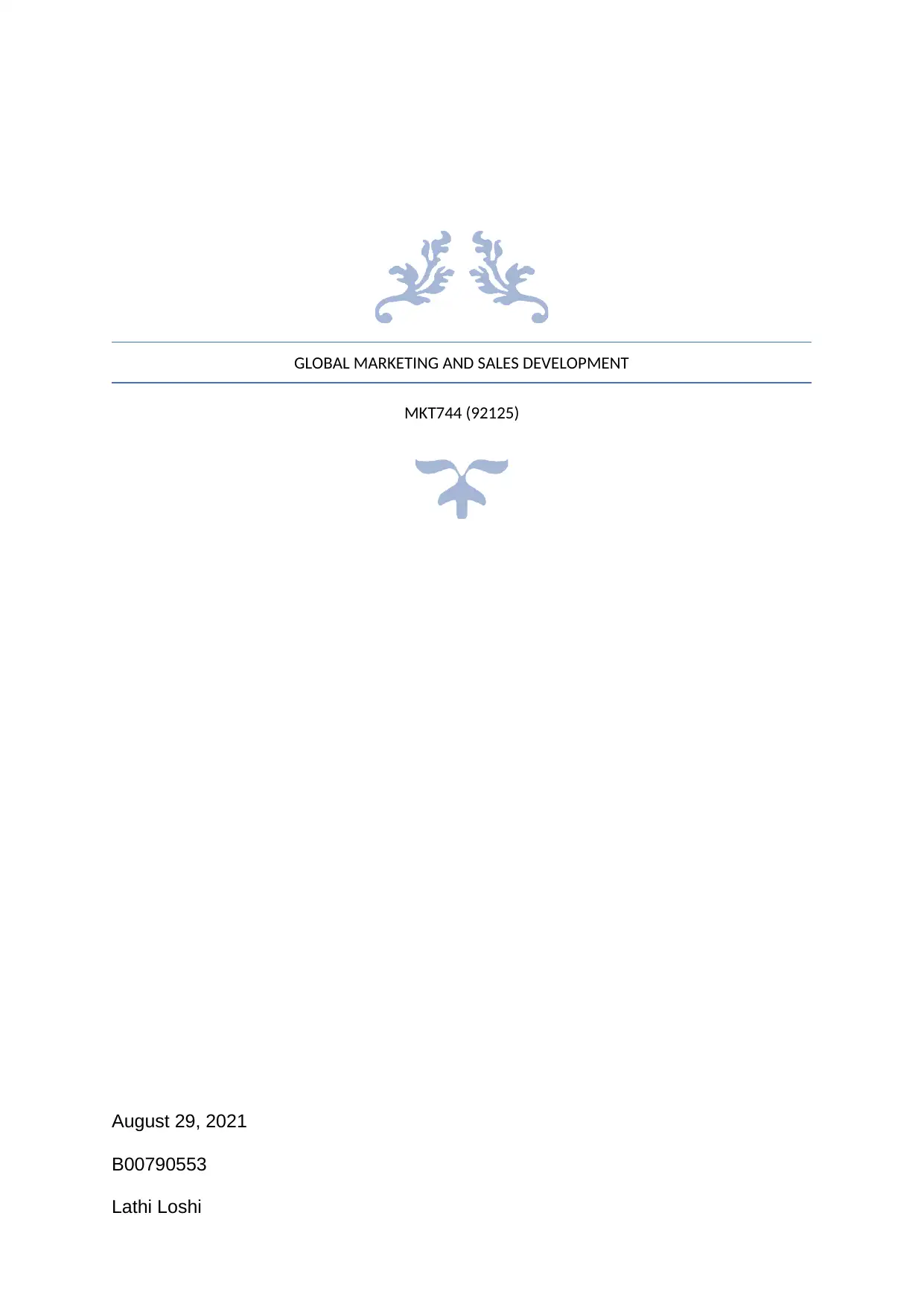
GLOBAL MARKETING AND SALES DEVELOPMENT
MKT744 (92125)
August 29, 2021
B00790553
Lathi Loshi
MKT744 (92125)
August 29, 2021
B00790553
Lathi Loshi
Paraphrase This Document
Need a fresh take? Get an instant paraphrase of this document with our AI Paraphraser
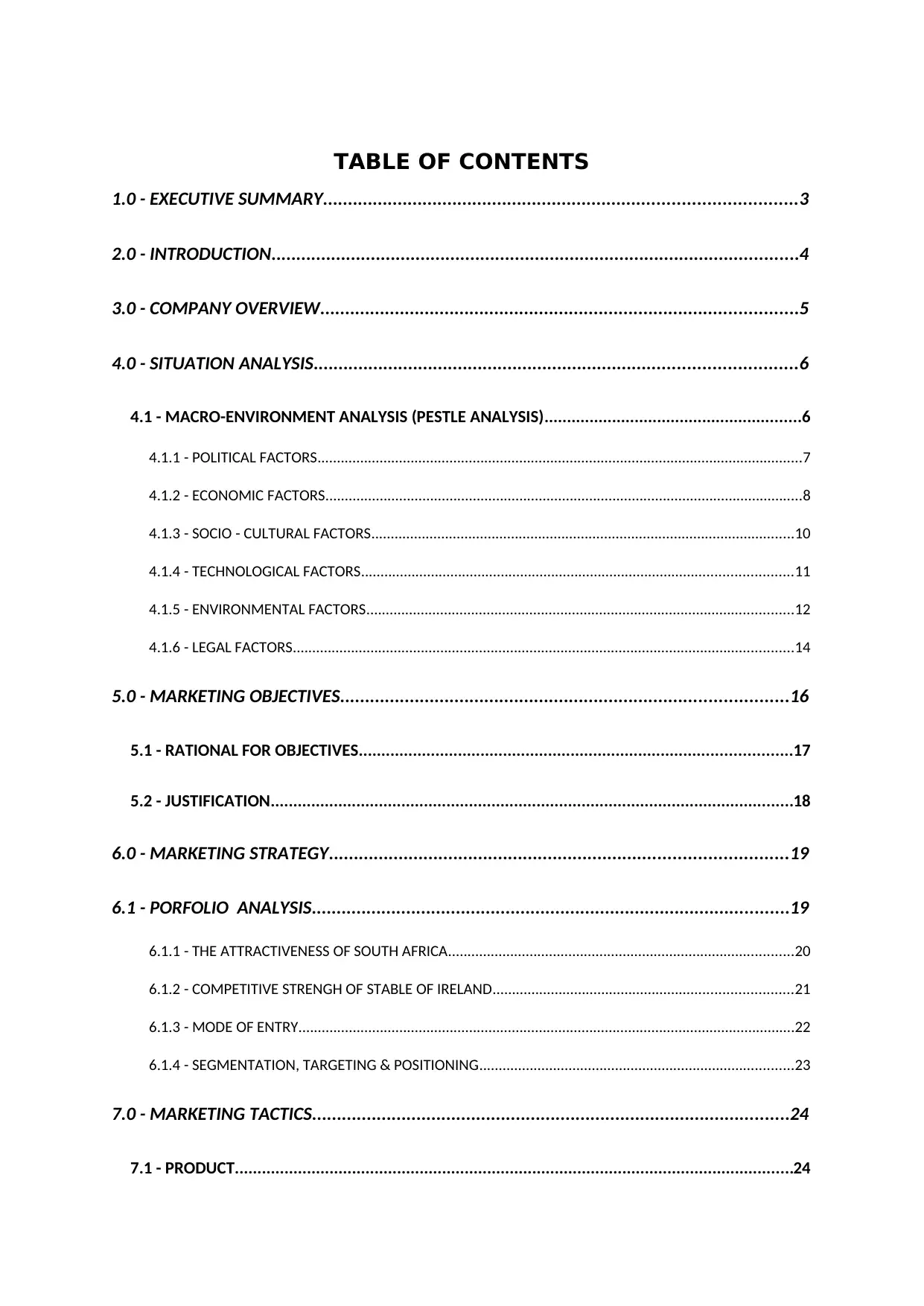
TABLE OF CONTENTS
1.0 - EXECUTIVE SUMMARY...............................................................................................3
2.0 - INTRODUCTION..........................................................................................................4
3.0 - COMPANY OVERVIEW................................................................................................5
4.0 - SITUATION ANALYSIS.................................................................................................6
4.1 - MACRO-ENVIRONMENT ANALYSIS (PESTLE ANALYSIS).........................................................6
4.1.1 - POLITICAL FACTORS.............................................................................................................................7
4.1.2 - ECONOMIC FACTORS...........................................................................................................................8
4.1.3 - SOCIO - CULTURAL FACTORS.............................................................................................................10
4.1.4 - TECHNOLOGICAL FACTORS...............................................................................................................11
4.1.5 - ENVIRONMENTAL FACTORS..............................................................................................................12
4.1.6 - LEGAL FACTORS.................................................................................................................................14
5.0 - MARKETING OBJECTIVES..........................................................................................16
5.1 - RATIONAL FOR OBJECTIVES................................................................................................17
5.2 - JUSTIFICATION....................................................................................................................18
6.0 - MARKETING STRATEGY............................................................................................19
6.1 - PORFOLIO ANALYSIS................................................................................................19
6.1.1 - THE ATTRACTIVENESS OF SOUTH AFRICA.........................................................................................20
6.1.2 - COMPETITIVE STRENGH OF STABLE OF IRELAND.............................................................................21
6.1.3 - MODE OF ENTRY................................................................................................................................22
6.1.4 - SEGMENTATION, TARGETING & POSITIONING.................................................................................23
7.0 - MARKETING TACTICS................................................................................................24
7.1 - PRODUCT............................................................................................................................24
1.0 - EXECUTIVE SUMMARY...............................................................................................3
2.0 - INTRODUCTION..........................................................................................................4
3.0 - COMPANY OVERVIEW................................................................................................5
4.0 - SITUATION ANALYSIS.................................................................................................6
4.1 - MACRO-ENVIRONMENT ANALYSIS (PESTLE ANALYSIS).........................................................6
4.1.1 - POLITICAL FACTORS.............................................................................................................................7
4.1.2 - ECONOMIC FACTORS...........................................................................................................................8
4.1.3 - SOCIO - CULTURAL FACTORS.............................................................................................................10
4.1.4 - TECHNOLOGICAL FACTORS...............................................................................................................11
4.1.5 - ENVIRONMENTAL FACTORS..............................................................................................................12
4.1.6 - LEGAL FACTORS.................................................................................................................................14
5.0 - MARKETING OBJECTIVES..........................................................................................16
5.1 - RATIONAL FOR OBJECTIVES................................................................................................17
5.2 - JUSTIFICATION....................................................................................................................18
6.0 - MARKETING STRATEGY............................................................................................19
6.1 - PORFOLIO ANALYSIS................................................................................................19
6.1.1 - THE ATTRACTIVENESS OF SOUTH AFRICA.........................................................................................20
6.1.2 - COMPETITIVE STRENGH OF STABLE OF IRELAND.............................................................................21
6.1.3 - MODE OF ENTRY................................................................................................................................22
6.1.4 - SEGMENTATION, TARGETING & POSITIONING.................................................................................23
7.0 - MARKETING TACTICS................................................................................................24
7.1 - PRODUCT............................................................................................................................24

7.2 - PRICE..................................................................................................................................25
7.3 - PLACE.................................................................................................................................26
7.4 - PROMOTION.......................................................................................................................27
8.0 - MARKETING ACTION PLAN.......................................................................................28
9.0 - CONCLUSION............................................................................................................29
10.0 - BIBLIOGRAPHY.......................................................................................................30
11.0 - APPENDIX 1 - MCKINSEY’S 7 S MODEL....................................................................37
11.1 - SHARED VALUES.................................................................................................................................37
11.2 - STRATEGY...........................................................................................................................................37
11.3 - STRUCTURE.........................................................................................................................................38
11.4 - SYSTEMS.............................................................................................................................................38
11.5 - STYLE...................................................................................................................................................38
11.6 - STAFF..................................................................................................................................................39
11.7 - SKILLS..................................................................................................................................................39
12.0 - APPENDIX 2 - PORTERS FIVE FORCES.......................................................................40
7.3 - PLACE.................................................................................................................................26
7.4 - PROMOTION.......................................................................................................................27
8.0 - MARKETING ACTION PLAN.......................................................................................28
9.0 - CONCLUSION............................................................................................................29
10.0 - BIBLIOGRAPHY.......................................................................................................30
11.0 - APPENDIX 1 - MCKINSEY’S 7 S MODEL....................................................................37
11.1 - SHARED VALUES.................................................................................................................................37
11.2 - STRATEGY...........................................................................................................................................37
11.3 - STRUCTURE.........................................................................................................................................38
11.4 - SYSTEMS.............................................................................................................................................38
11.5 - STYLE...................................................................................................................................................38
11.6 - STAFF..................................................................................................................................................39
11.7 - SKILLS..................................................................................................................................................39
12.0 - APPENDIX 2 - PORTERS FIVE FORCES.......................................................................40
⊘ This is a preview!⊘
Do you want full access?
Subscribe today to unlock all pages.

Trusted by 1+ million students worldwide

1.0 - EXECUTIVE SUMMARY
This report will evaluate the globalisation of Stable of Ireland into South Africa.
Founded in 2015, Stable of Ireland crafts handmade luxury ready-to-wear and home
textiles. As an SME, the short term objectives of Stable are to sustain online and
retail sales, with the long term objective to expand internationally; South Africa being
a prime location due to its economically steady and technologically advanced status.
A thorough PESTLE analysis has been conducted, covering political, economic,
socio-cultural, technological, environmental and legal factors that would effect the
internationalisation strategy. The evaluation demonstrates greater prospects than
risk, with the South African textile industry value expected to rise 6 billion in 7 years.
Careful consideration has been given to the methods employed to execute Stable of
Ireland’s business plan, namely market penetration and exporting. Porters Five
Forces and Mckinsey’s 7 S model have also been used as a means of analysis in
this report to further explore the competitive environment amongst other factors.
This report will evaluate the globalisation of Stable of Ireland into South Africa.
Founded in 2015, Stable of Ireland crafts handmade luxury ready-to-wear and home
textiles. As an SME, the short term objectives of Stable are to sustain online and
retail sales, with the long term objective to expand internationally; South Africa being
a prime location due to its economically steady and technologically advanced status.
A thorough PESTLE analysis has been conducted, covering political, economic,
socio-cultural, technological, environmental and legal factors that would effect the
internationalisation strategy. The evaluation demonstrates greater prospects than
risk, with the South African textile industry value expected to rise 6 billion in 7 years.
Careful consideration has been given to the methods employed to execute Stable of
Ireland’s business plan, namely market penetration and exporting. Porters Five
Forces and Mckinsey’s 7 S model have also been used as a means of analysis in
this report to further explore the competitive environment amongst other factors.
Paraphrase This Document
Need a fresh take? Get an instant paraphrase of this document with our AI Paraphraser

2.0 - INTRODUCTION
International marketing is the utilization of marketing standards to fulfil the diverse
necessities and demands of various individuals living over the national precincts.
(Vellas, 2016). An advantage of international marketing is the rise in returns because
the additional transactions equivalents to more returns. So it is gainful for
organisations to access international markets (Oumlil, et al., 2015). However, a
disadvantage of international marketing is infrastructure because the anchor nation
infrastructure may not be established which may cause hindrances for the
organisations (Surugiu & Surugiu, 2015). Nike, McDonalds and Coca cola are
examples of organisations who are involved in international marketing. McDonalds’s
brings a native taste, truly, to various nations with regional menu necessities for
instance, the McArabia, a flatbread sandwich, to their middle eastern menu,
macaroons to their French menu and McSpaghetti to their Philippines menu (Mathur,
2017). An controllable factor in international marketing is the marketing mix which
consist of product, price, place and promotion (Gupta, 2017). According to (Cateora,
et al., 2015) the phases of international marketing are infrequent foreign marketing,
regular foreign marketing, international marketing and global marketing. This report
will firstly scrutinize and critically evaluate South Africa business environment by
utilising an PESTLE analysis framework. Secondly the operational environment
utilising Michael Porter 5 Forces and finally the internal analysis of the company
utilising the McKinsey 7S framework. The discoveries will influence the direction of
the marketing strategies and objectives for internationalising into the South African
business environment.
International marketing is the utilization of marketing standards to fulfil the diverse
necessities and demands of various individuals living over the national precincts.
(Vellas, 2016). An advantage of international marketing is the rise in returns because
the additional transactions equivalents to more returns. So it is gainful for
organisations to access international markets (Oumlil, et al., 2015). However, a
disadvantage of international marketing is infrastructure because the anchor nation
infrastructure may not be established which may cause hindrances for the
organisations (Surugiu & Surugiu, 2015). Nike, McDonalds and Coca cola are
examples of organisations who are involved in international marketing. McDonalds’s
brings a native taste, truly, to various nations with regional menu necessities for
instance, the McArabia, a flatbread sandwich, to their middle eastern menu,
macaroons to their French menu and McSpaghetti to their Philippines menu (Mathur,
2017). An controllable factor in international marketing is the marketing mix which
consist of product, price, place and promotion (Gupta, 2017). According to (Cateora,
et al., 2015) the phases of international marketing are infrequent foreign marketing,
regular foreign marketing, international marketing and global marketing. This report
will firstly scrutinize and critically evaluate South Africa business environment by
utilising an PESTLE analysis framework. Secondly the operational environment
utilising Michael Porter 5 Forces and finally the internal analysis of the company
utilising the McKinsey 7S framework. The discoveries will influence the direction of
the marketing strategies and objectives for internationalising into the South African
business environment.
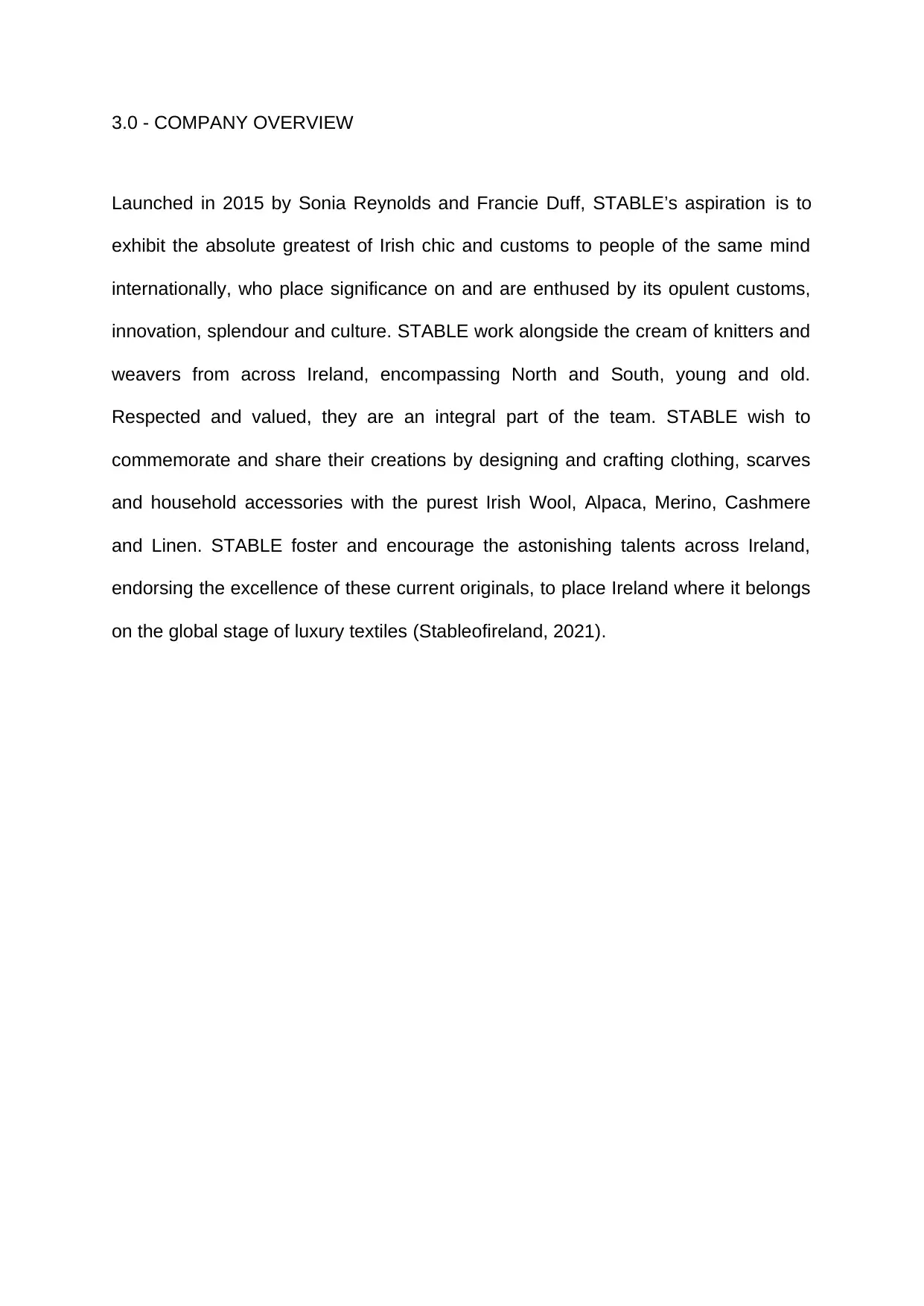
3.0 - COMPANY OVERVIEW
Launched in 2015 by Sonia Reynolds and Francie Duff, STABLE’s aspiration is to
exhibit the absolute greatest of Irish chic and customs to people of the same mind
internationally, who place significance on and are enthused by its opulent customs,
innovation, splendour and culture. STABLE work alongside the cream of knitters and
weavers from across Ireland, encompassing North and South, young and old.
Respected and valued, they are an integral part of the team. STABLE wish to
commemorate and share their creations by designing and crafting clothing, scarves
and household accessories with the purest Irish Wool, Alpaca, Merino, Cashmere
and Linen. STABLE foster and encourage the astonishing talents across Ireland,
endorsing the excellence of these current originals, to place Ireland where it belongs
on the global stage of luxury textiles (Stableofireland, 2021).
Launched in 2015 by Sonia Reynolds and Francie Duff, STABLE’s aspiration is to
exhibit the absolute greatest of Irish chic and customs to people of the same mind
internationally, who place significance on and are enthused by its opulent customs,
innovation, splendour and culture. STABLE work alongside the cream of knitters and
weavers from across Ireland, encompassing North and South, young and old.
Respected and valued, they are an integral part of the team. STABLE wish to
commemorate and share their creations by designing and crafting clothing, scarves
and household accessories with the purest Irish Wool, Alpaca, Merino, Cashmere
and Linen. STABLE foster and encourage the astonishing talents across Ireland,
endorsing the excellence of these current originals, to place Ireland where it belongs
on the global stage of luxury textiles (Stableofireland, 2021).
⊘ This is a preview!⊘
Do you want full access?
Subscribe today to unlock all pages.

Trusted by 1+ million students worldwide
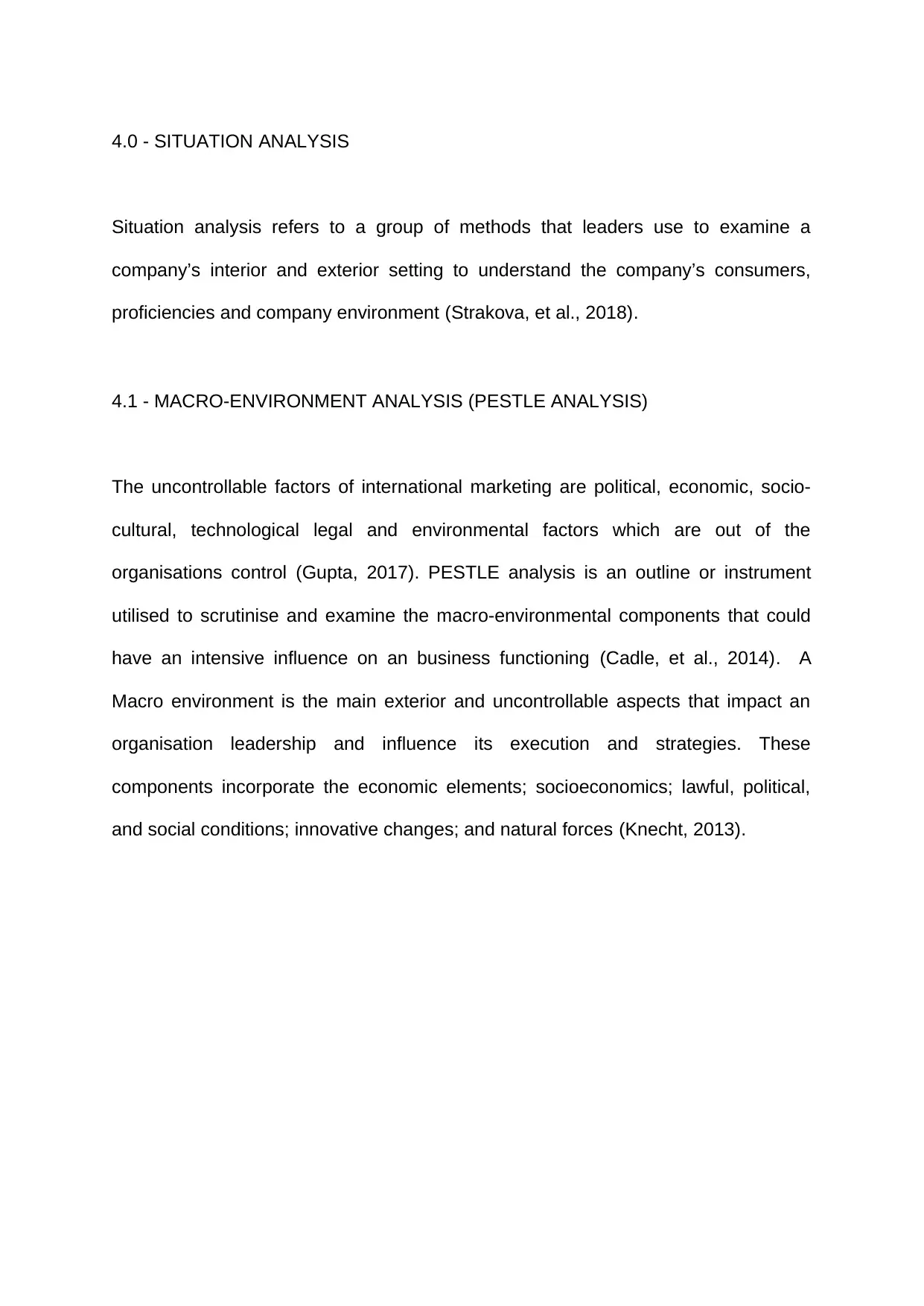
4.0 - SITUATION ANALYSIS
Situation analysis refers to a group of methods that leaders use to examine a
company’s interior and exterior setting to understand the company’s consumers,
proficiencies and company environment (Strakova, et al., 2018).
4.1 - MACRO-ENVIRONMENT ANALYSIS (PESTLE ANALYSIS)
The uncontrollable factors of international marketing are political, economic, socio-
cultural, technological legal and environmental factors which are out of the
organisations control (Gupta, 2017). PESTLE analysis is an outline or instrument
utilised to scrutinise and examine the macro-environmental components that could
have an intensive influence on an business functioning (Cadle, et al., 2014). A
Macro environment is the main exterior and uncontrollable aspects that impact an
organisation leadership and influence its execution and strategies. These
components incorporate the economic elements; socioeconomics; lawful, political,
and social conditions; innovative changes; and natural forces (Knecht, 2013).
Situation analysis refers to a group of methods that leaders use to examine a
company’s interior and exterior setting to understand the company’s consumers,
proficiencies and company environment (Strakova, et al., 2018).
4.1 - MACRO-ENVIRONMENT ANALYSIS (PESTLE ANALYSIS)
The uncontrollable factors of international marketing are political, economic, socio-
cultural, technological legal and environmental factors which are out of the
organisations control (Gupta, 2017). PESTLE analysis is an outline or instrument
utilised to scrutinise and examine the macro-environmental components that could
have an intensive influence on an business functioning (Cadle, et al., 2014). A
Macro environment is the main exterior and uncontrollable aspects that impact an
organisation leadership and influence its execution and strategies. These
components incorporate the economic elements; socioeconomics; lawful, political,
and social conditions; innovative changes; and natural forces (Knecht, 2013).
Paraphrase This Document
Need a fresh take? Get an instant paraphrase of this document with our AI Paraphraser
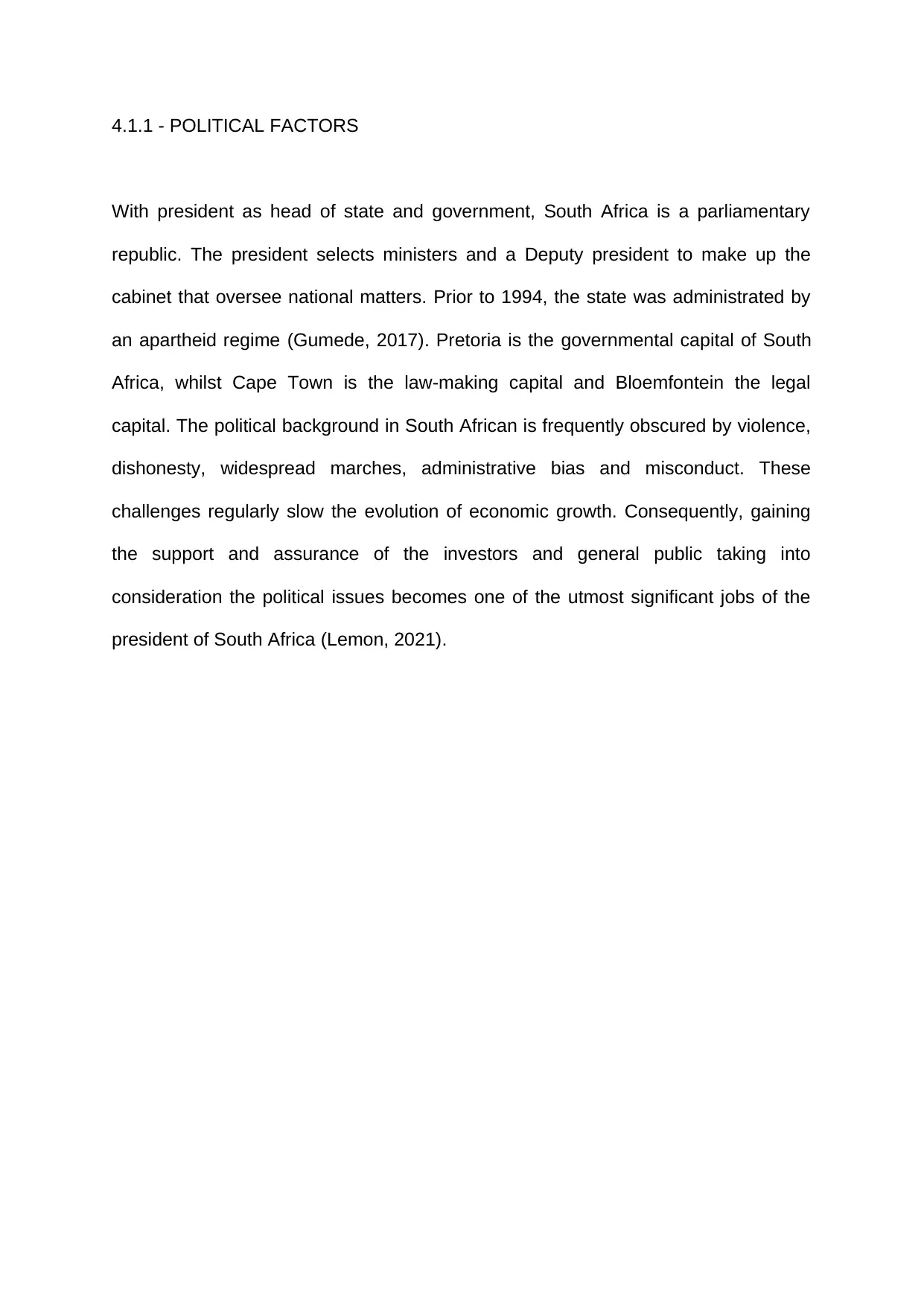
4.1.1 - POLITICAL FACTORS
With president as head of state and government, South Africa is a parliamentary
republic. The president selects ministers and a Deputy president to make up the
cabinet that oversee national matters. Prior to 1994, the state was administrated by
an apartheid regime (Gumede, 2017). Pretoria is the governmental capital of South
Africa, whilst Cape Town is the law-making capital and Bloemfontein the legal
capital. The political background in South African is frequently obscured by violence,
dishonesty, widespread marches, administrative bias and misconduct. These
challenges regularly slow the evolution of economic growth. Consequently, gaining
the support and assurance of the investors and general public taking into
consideration the political issues becomes one of the utmost significant jobs of the
president of South Africa (Lemon, 2021).
With president as head of state and government, South Africa is a parliamentary
republic. The president selects ministers and a Deputy president to make up the
cabinet that oversee national matters. Prior to 1994, the state was administrated by
an apartheid regime (Gumede, 2017). Pretoria is the governmental capital of South
Africa, whilst Cape Town is the law-making capital and Bloemfontein the legal
capital. The political background in South African is frequently obscured by violence,
dishonesty, widespread marches, administrative bias and misconduct. These
challenges regularly slow the evolution of economic growth. Consequently, gaining
the support and assurance of the investors and general public taking into
consideration the political issues becomes one of the utmost significant jobs of the
president of South Africa (Lemon, 2021).
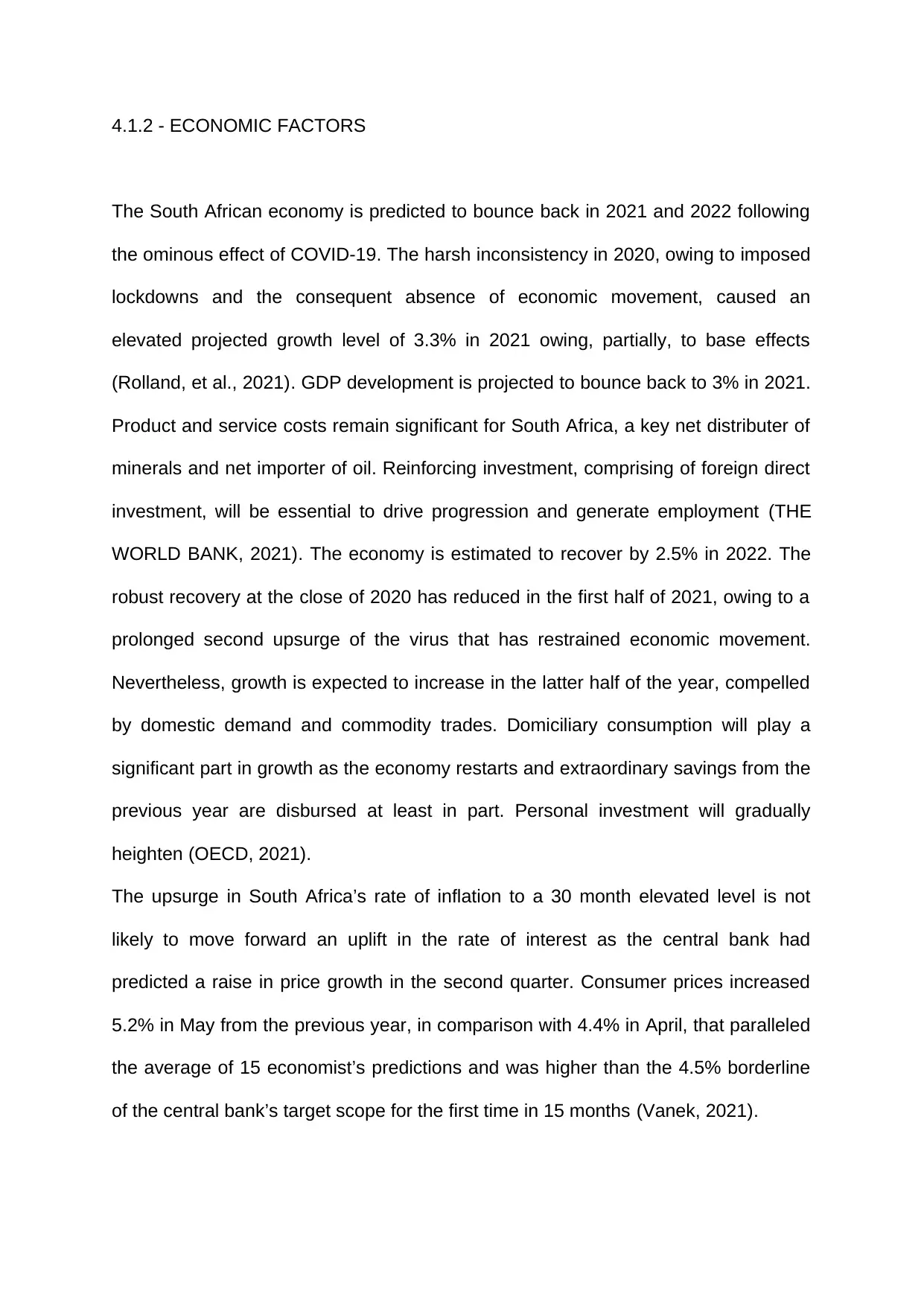
4.1.2 - ECONOMIC FACTORS
The South African economy is predicted to bounce back in 2021 and 2022 following
the ominous effect of COVID-19. The harsh inconsistency in 2020, owing to imposed
lockdowns and the consequent absence of economic movement, caused an
elevated projected growth level of 3.3% in 2021 owing, partially, to base effects
(Rolland, et al., 2021). GDP development is projected to bounce back to 3% in 2021.
Product and service costs remain significant for South Africa, a key net distributer of
minerals and net importer of oil. Reinforcing investment, comprising of foreign direct
investment, will be essential to drive progression and generate employment (THE
WORLD BANK, 2021). The economy is estimated to recover by 2.5% in 2022. The
robust recovery at the close of 2020 has reduced in the first half of 2021, owing to a
prolonged second upsurge of the virus that has restrained economic movement.
Nevertheless, growth is expected to increase in the latter half of the year, compelled
by domestic demand and commodity trades. Domiciliary consumption will play a
significant part in growth as the economy restarts and extraordinary savings from the
previous year are disbursed at least in part. Personal investment will gradually
heighten (OECD, 2021).
The upsurge in South Africa’s rate of inflation to a 30 month elevated level is not
likely to move forward an uplift in the rate of interest as the central bank had
predicted a raise in price growth in the second quarter. Consumer prices increased
5.2% in May from the previous year, in comparison with 4.4% in April, that paralleled
the average of 15 economist’s predictions and was higher than the 4.5% borderline
of the central bank’s target scope for the first time in 15 months (Vanek, 2021).
The South African economy is predicted to bounce back in 2021 and 2022 following
the ominous effect of COVID-19. The harsh inconsistency in 2020, owing to imposed
lockdowns and the consequent absence of economic movement, caused an
elevated projected growth level of 3.3% in 2021 owing, partially, to base effects
(Rolland, et al., 2021). GDP development is projected to bounce back to 3% in 2021.
Product and service costs remain significant for South Africa, a key net distributer of
minerals and net importer of oil. Reinforcing investment, comprising of foreign direct
investment, will be essential to drive progression and generate employment (THE
WORLD BANK, 2021). The economy is estimated to recover by 2.5% in 2022. The
robust recovery at the close of 2020 has reduced in the first half of 2021, owing to a
prolonged second upsurge of the virus that has restrained economic movement.
Nevertheless, growth is expected to increase in the latter half of the year, compelled
by domestic demand and commodity trades. Domiciliary consumption will play a
significant part in growth as the economy restarts and extraordinary savings from the
previous year are disbursed at least in part. Personal investment will gradually
heighten (OECD, 2021).
The upsurge in South Africa’s rate of inflation to a 30 month elevated level is not
likely to move forward an uplift in the rate of interest as the central bank had
predicted a raise in price growth in the second quarter. Consumer prices increased
5.2% in May from the previous year, in comparison with 4.4% in April, that paralleled
the average of 15 economist’s predictions and was higher than the 4.5% borderline
of the central bank’s target scope for the first time in 15 months (Vanek, 2021).
⊘ This is a preview!⊘
Do you want full access?
Subscribe today to unlock all pages.

Trusted by 1+ million students worldwide
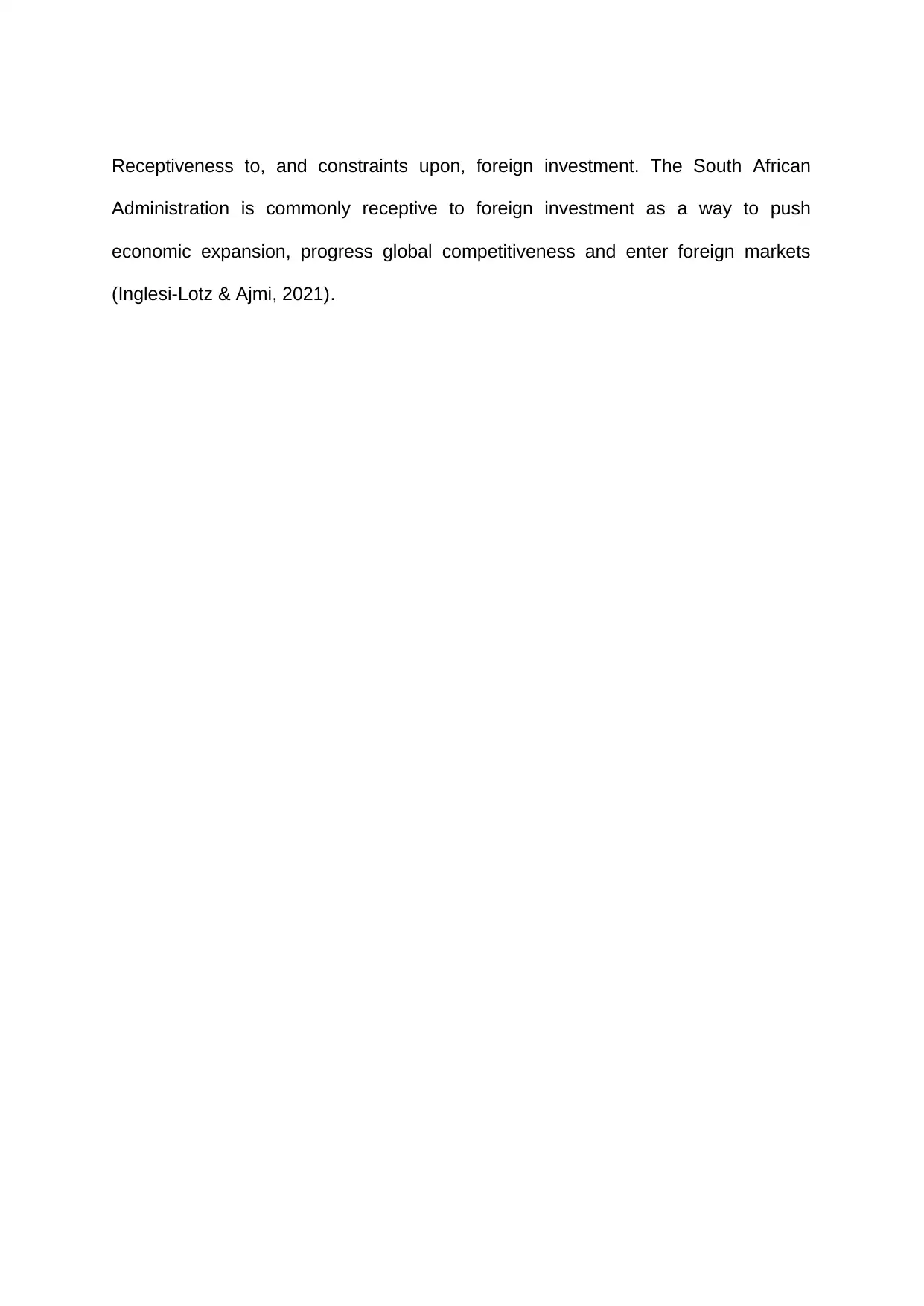
Receptiveness to, and constraints upon, foreign investment. The South African
Administration is commonly receptive to foreign investment as a way to push
economic expansion, progress global competitiveness and enter foreign markets
(Inglesi-Lotz & Ajmi, 2021).
Administration is commonly receptive to foreign investment as a way to push
economic expansion, progress global competitiveness and enter foreign markets
(Inglesi-Lotz & Ajmi, 2021).
Paraphrase This Document
Need a fresh take? Get an instant paraphrase of this document with our AI Paraphraser
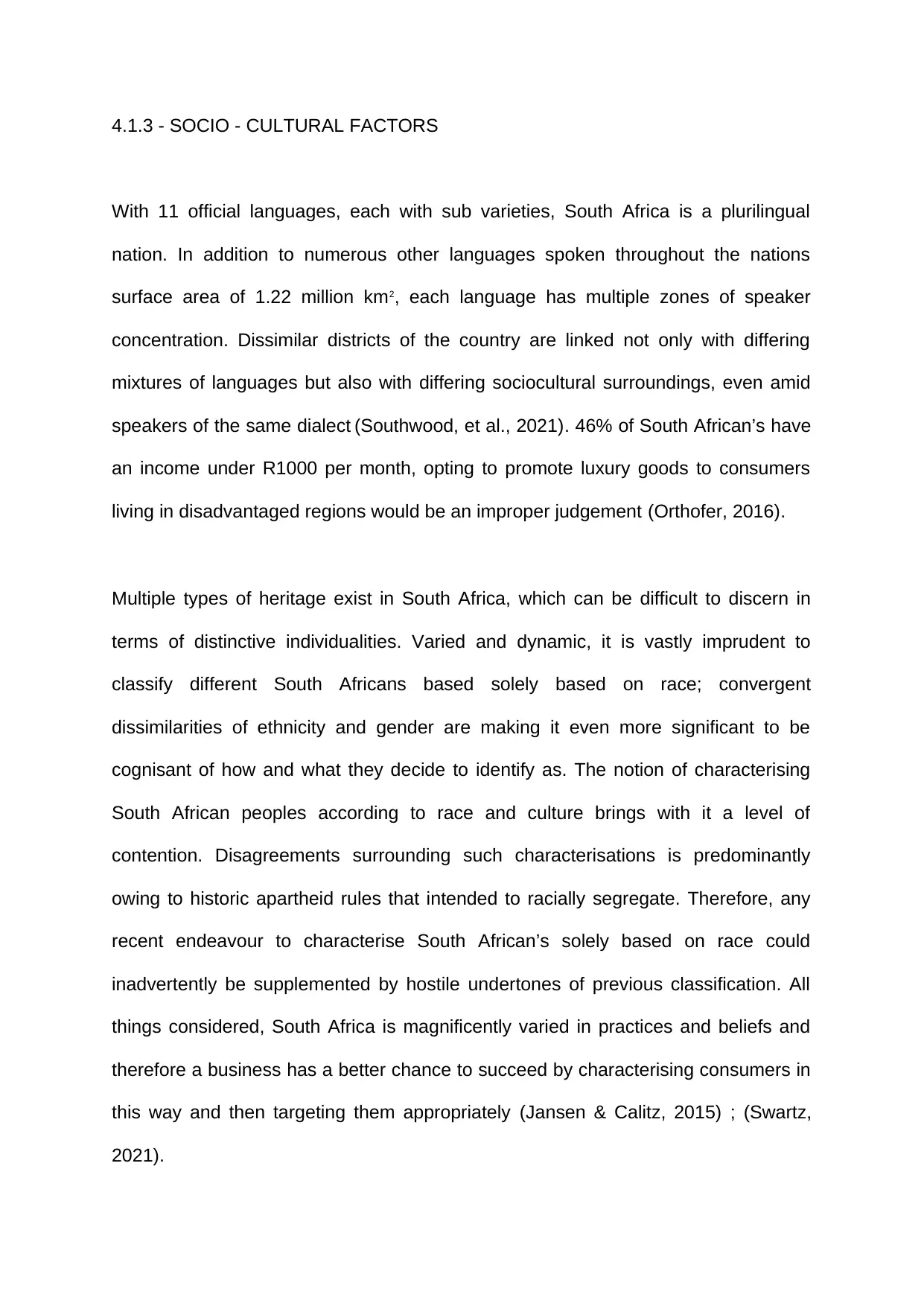
4.1.3 - SOCIO - CULTURAL FACTORS
With 11 official languages, each with sub varieties, South Africa is a plurilingual
nation. In addition to numerous other languages spoken throughout the nations
surface area of 1.22 million km2, each language has multiple zones of speaker
concentration. Dissimilar districts of the country are linked not only with differing
mixtures of languages but also with differing sociocultural surroundings, even amid
speakers of the same dialect (Southwood, et al., 2021). 46% of South African’s have
an income under R1000 per month, opting to promote luxury goods to consumers
living in disadvantaged regions would be an improper judgement (Orthofer, 2016).
Multiple types of heritage exist in South Africa, which can be difficult to discern in
terms of distinctive individualities. Varied and dynamic, it is vastly imprudent to
classify different South Africans based solely based on race; convergent
dissimilarities of ethnicity and gender are making it even more significant to be
cognisant of how and what they decide to identify as. The notion of characterising
South African peoples according to race and culture brings with it a level of
contention. Disagreements surrounding such characterisations is predominantly
owing to historic apartheid rules that intended to racially segregate. Therefore, any
recent endeavour to characterise South African’s solely based on race could
inadvertently be supplemented by hostile undertones of previous classification. All
things considered, South Africa is magnificently varied in practices and beliefs and
therefore a business has a better chance to succeed by characterising consumers in
this way and then targeting them appropriately (Jansen & Calitz, 2015) ; (Swartz,
2021).
With 11 official languages, each with sub varieties, South Africa is a plurilingual
nation. In addition to numerous other languages spoken throughout the nations
surface area of 1.22 million km2, each language has multiple zones of speaker
concentration. Dissimilar districts of the country are linked not only with differing
mixtures of languages but also with differing sociocultural surroundings, even amid
speakers of the same dialect (Southwood, et al., 2021). 46% of South African’s have
an income under R1000 per month, opting to promote luxury goods to consumers
living in disadvantaged regions would be an improper judgement (Orthofer, 2016).
Multiple types of heritage exist in South Africa, which can be difficult to discern in
terms of distinctive individualities. Varied and dynamic, it is vastly imprudent to
classify different South Africans based solely based on race; convergent
dissimilarities of ethnicity and gender are making it even more significant to be
cognisant of how and what they decide to identify as. The notion of characterising
South African peoples according to race and culture brings with it a level of
contention. Disagreements surrounding such characterisations is predominantly
owing to historic apartheid rules that intended to racially segregate. Therefore, any
recent endeavour to characterise South African’s solely based on race could
inadvertently be supplemented by hostile undertones of previous classification. All
things considered, South Africa is magnificently varied in practices and beliefs and
therefore a business has a better chance to succeed by characterising consumers in
this way and then targeting them appropriately (Jansen & Calitz, 2015) ; (Swartz,
2021).

4.1.4 - TECHNOLOGICAL FACTORS
South Africa has a technologically hi-tech manufacturing, mining and service
economy that propels economic development. South Africa upholds a strong
innovation structure that has permitted it to be one of the sturdiest scientific and
technologically established nations in Africa (Scerri, 2009). Additionally, South Africa
is a provincial frontrunner in the implementation of numerous developing
technologies, for instance drones in quarrying, biometric information and payment
cards to provide social security, which assists in keeping the nation at a pioneering
advantage (Chakravorti & Chaturvedi, 2019). Several global technology and social
network organisations already function in South Africa regularly by way of
subsidiaries. The increase in velocity regarding e-commerce in the nation
emphasises advances in how merchants get products to consumers. Shopping
online is on the increase in South Africa. Therefore, numerous prospects are
presented for online merchants. Similarly, owing to several prominent malware
attacks and additional susceptibilities, need for IT protection products and software is
elevated as well. South African organisations sell a large amount of IT products to
emerging African markets (Browdie, 2021).
South Africa has a technologically hi-tech manufacturing, mining and service
economy that propels economic development. South Africa upholds a strong
innovation structure that has permitted it to be one of the sturdiest scientific and
technologically established nations in Africa (Scerri, 2009). Additionally, South Africa
is a provincial frontrunner in the implementation of numerous developing
technologies, for instance drones in quarrying, biometric information and payment
cards to provide social security, which assists in keeping the nation at a pioneering
advantage (Chakravorti & Chaturvedi, 2019). Several global technology and social
network organisations already function in South Africa regularly by way of
subsidiaries. The increase in velocity regarding e-commerce in the nation
emphasises advances in how merchants get products to consumers. Shopping
online is on the increase in South Africa. Therefore, numerous prospects are
presented for online merchants. Similarly, owing to several prominent malware
attacks and additional susceptibilities, need for IT protection products and software is
elevated as well. South African organisations sell a large amount of IT products to
emerging African markets (Browdie, 2021).
⊘ This is a preview!⊘
Do you want full access?
Subscribe today to unlock all pages.

Trusted by 1+ million students worldwide
1 out of 42
Your All-in-One AI-Powered Toolkit for Academic Success.
+13062052269
info@desklib.com
Available 24*7 on WhatsApp / Email
![[object Object]](/_next/static/media/star-bottom.7253800d.svg)
Unlock your academic potential
Copyright © 2020–2025 A2Z Services. All Rights Reserved. Developed and managed by ZUCOL.

